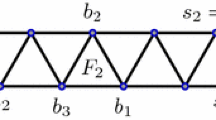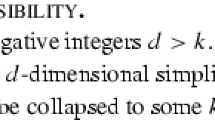Abstract
We present extremal constructions connected with the property of simplicial collapsibility. (1) For each \(d \ge 2\), there are collapsible (and shellable) simplicial d-complexes with only one free face. Also, there are non-evasive d-complexes with only two free faces (both results are optimal in all dimensions). (2) Optimal discrete Morse vectors need not be unique. We explicitly construct a contractible, but non-collapsible 3-dimensional simplicial complex with face vector \(f=(106,596,1064,573)\) that admits two distinct optimal discrete Morse vectors, (1, 1, 1, 0) and (1, 0, 1, 1). Indeed, we show that in every dimension \(d\ge 3\) there are contractible, non-collapsible simplicial d-complexes that have \((1,0,\dots ,0,1,1,0)\) and \((1,0,\dots ,0,0,1,1)\) as distinct optimal discrete Morse vectors. (3) We give a first explicit example of a (non-PL) 5-manifold, with face vector \(f=(5013,72300,290944,\) 495912, 383136, 110880), that is collapsible but not homeomorphic to a ball. Furthermore, we discuss possible improvements and drawbacks of random approaches to collapsibility and discrete Morse theory. We will introduce randomized versions random-lex-first and random-lex-last of the lex-first and lex-last discrete Morse strategies of Benedetti and Lutz (Exp Math 23(1):66–94, 2014), respectively—and we will see that in many instances the random-lex-last strategy works significantly better than Benedetti–Lutz’s (uniform) random strategy. On the theoretical side, we prove that after repeated barycentric subdivisions, the discrete Morse vectors found by randomized algorithms have, on average, an exponential (in the number of barycentric subdivisions) number of critical cells asymptotically almost surely.









Similar content being viewed by others
Notes
By a result of Adiprasito–Benedetti [2], if some subdivision of a complex C is collapsible, then also some iterated barycentric subdivision of C is collapsible.
Of course, observing this phenomenon experimentally may be difficult, due to (1) computational expense of treating barycentric subdivisions after the first or second iteration, (2) the possibility that the probabilities \(p_1\), \(p_2\), and \(p_3\) determined by Lemma 5.1 below are so small that one needs an extremely large \(\ell \) to appreciate the effect.
References
Adiprasito, K., Benedetti, B.: Metric geometry, convexity and collapsibility. arXiv:1107.5789 (2011)
Adiprasito, K.A., Benedetti, B.: Subdivisions, shellability, and collapsibility of products. Combinatorica. doi:10.1007/s00493-016-3149-8. arXiv:1202.6606 (2016)
Adiprasito, K.A., Izmestiev, I.: Derived subdivisions make every PL sphere polytopal. Isr. J. Math. 208(1), 443–450 (2015)
Benedetti, B.: Discrete Morse theory for manifolds with boundary. Trans. Am. Math. Soc. 364(12), 6631–6670 (2012)
Benedetti, B.: Smoothing discrete Morse theory. Ann. Sc. Norm. Super. Pisa, Cl. Sci. 16(2), 335–368 (2016)
Benedetti, B., Lutz, F.H.: Knots in collapsible and non-collapsible balls. Electron. J. Comb. 20(3), Research Paper P31 (2013)
Benedetti, B., Lutz, F.H.: The dunce hat and a minimal non-extendably collapsible \(3\)-ball. Electronic Geometry Models, Model 2013.10.001. http://www.eg-models.de/2013.10.001 (2013)
Benedetti, B., Lutz, F.H.: Random discrete Morse theory and a new library of triangulations. Exp. Math. 23(1), 66–94 (2014)
Benedetti, B., Lutz, F.H.: Library of triangulations, 2013–2016. http://page.math.tu-berlin.de/~lutz/stellar/library_of_triangulations
Björner, A., Lutz, F.H.: Simplicial manifolds, bistellar flips and a \(16\)-vertex triangulation of the Poincaré homology \(3\)-sphere. Exp. Math. 9(2), 275–289 (2000)
Bruggesser, H., Mani, P.: Shellable decompositions of cells and spheres. Math. Scand. 29, 197–205 (1971)
Cannon, J.W.: Shrinking cell-like decompositions of manifolds. Codimension three. Ann. Math. 110(1), 83–112 (1979)
CAPD::RedHom: Redhom software library. http://redhom.ii.uj.edu.pl
CHomP: Computational Homology Project. http://chomp.rutgers.edu
Crowley, K., Ebin, A., Kahn, H., Reyfman, P., White, J., Xue, M.: Collapsing a simplex to a noncollapsible simplicial complex (2003, preprint)
De Loera, J.A., Rambau, J., Santos, F.: Triangulations. Structures for Algorithms and Applications. Algorithms and Computation in Mathematics, vol. 25. Springer, Berlin (2010)
Edwards, R.D.: The double suspension of a certain homology \(3\)-sphere is \(S^5\). Notices Am. Math. Soc. 22, A–334 (1975)
Forman, R.: Morse theory for cell complexes. Adv. Math. 134(1), 90–145 (1998)
Forman, R.: A user’s guide to discrete Morse theory. Sémin. Lothar. Comb. 48, B48c (2002)
Gawrilow, E., Joswig, M.: polymake: A Framework for analyzing convex polytopes. In: Kalai, G., Ziegler, G.M. (eds.) Polytopes—Combinatorics and Computation. DMV Seminar, vol. 29, pp. 43–73. Birkhäuser, Basel. https://polymake.org/doku.php (2000)
Joswig, M., Lutz, F.H., Tsuruga, M.: Sphere recognition: heuristics and examples. arXiv:1405.3848 (2015)
Joswig, M., Pfetsch, M.E.: Computing optimal Morse matchings. SIAM J. Discrete Math. 20(1), 11–25 (2006)
Lewiner, T.: Geometric discrete Morse complexes. PhD thesis. Pontifícia Universidade Católica do Rio de Janeiro, Rio de Janeiro. http://thomas.lewiner.org/pdfs/tomlew_phd_puc (2005)
Lewiner, T., Lopes, H., Tavares, G.: Optimal discrete Morse functions for \(2\)-manifolds. Comput. Geom. 26(3), 221–233 (2003)
Lutz, F.H.: Small examples of nonconstructible simplicial balls and spheres. SIAM J. Discrete Math. 18(1), 103–109 (2004)
Lutz, F.H.: Triangulated manifolds with few vertices: geometric \(3\)-manifolds. arXiv:math/0311116 (2003)
Lutz, F.H.: DiscreteMorse, Version May/2015. http://page.math.tu-berlin.de/~lutz/stellar/DiscreteMorse (2015)
Lutz, F.H.: A shellable \(3\)-ball with one ear (in preparation)
Lutz, F.H., Sulanke, T., Swartz, E.: \(f\)-Vectors of \(3\)-manifolds. Electron. J. Comb. 16(2), Research Paper R13 (2009)
Perseus: The persistent homology software. http://people.maths.ox.ac.uk/nanda/perseus
Tancer, M.: Recognition of collapsible complexes is NP-complete. Discrete Comput. Geom. 55(1), 21–38 (2016)
The GAP Group: GAP—Groups, Algorithms, Programming, Version 4.7.7. http://www.gap-system.org (2015)
Tsuruga, M., Lutz, F.H.: Constructing complicated spheres. arXiv:1302.6856 (2013)
Volodin, I.A., Kuznetsov, V.E., Fomenko, A.T.: The problem of discriminating algorithmically the standard three-dimensional sphere. Russ. Math. Surv. 29(5), 71–172 (1974)
Welker, V.: Constructions preserving evasiveness and collapsibility. Discrete Math. 207(1–3), 243–255 (1999)
Whitehead, J.H.C.: Simplicial spaces, nuclei and \(m\)-groups. Proc. Lond. Math. Soc., II. Ser. 45, 243–327 (1939)
Zeeman, E.C.: Seminar on Combinatorial Topology. Institut des Hautes Études Scientifiques, Paris (1966)
Acknowledgements
We are grateful to the anonymous referees for valuable comments that greatly helped to improve the presentation of the paper. Karim Adiprasito acknowledges support by a Minerva fellowship of the Max Planck Society, NSF Grant DMS 1128155, ISF Grant 1050/16 and ERC StG 716424 - CASe. Bruno Benedetti was supported by the DFG Coll. Research Center TRR 109, “Discretization in Geometry and Dynamics” and NSF Grant 1600741, “Geometric Combinatorics and Discrete Morse Theory”. Frank H. Lutz was supported by the DFG Research Group “Polyhedral Surfaces”, by the DFG Coll. Research Center TRR 109, “Discretization in Geometry and Dynamics”, by VILLUM FONDEN through the Experimental Mathematics Network and by the Danish National Research Foundation (DNRF) through the Centre for Symmetry and Deformation.
Author information
Authors and Affiliations
Corresponding author
Additional information
Editor in Charge: Herbert Edelsbrunner
Appendix: Random-Lex-First and Random-Lex-Last Strategies
Appendix: Random-Lex-First and Random-Lex-Last Strategies
In [8], the random discrete Morse strategy was used to search for small discrete Morse vectors for various input. As pointed out in the previous section, this random procedure, and also the random versions random-lex-first and random-lex-last of the deterministic strategies lex-first and lex-last of [8], respectively, pick up exponentially many critical cells asymptotically almost surely. Yet, on rather huge examples the heuristics often still are successful in finding good or even optimal discrete Morse vectors—with the new random-lex-last strategy working significantly better than the other implementations; cf. Table 2.
As a (non-trivial) testing ground for discrete Morse (heuristical) algorithms, a library of 45 triangulations is provided in [8]. For 39 out of the 45 examples, optimal discrete Morse vectors were found in [8] with the discrete Morse strategy random or with the lex-first and lex-last strategies. For four of the six open cases,
-
hyperbolic_dodecahedral_space, (1,4,4,1),
-
non_PL, (1,0,0,2,2,1),
-
S2xpoincare, (1,2,3,3,2,1),
-
contractible_vertex_homogeneous, (1,0,0,4,8,4,0,0,0,0,0,0),
we miss appropriate lower bounds to show optimality of the found discrete Morse vectors. In the case of the 3-ball triangulation knot, (1,1,1,0) was the best vector obtained in [8], while Lewiner claims in [23, p. 92] to have found (1,0,0,0). For the example triple_trefoil_bsd, (1,1,1,1) was reached in [8].
Theorem 5.7
The triangulated 3-sphere example triple_trefoil_bsd has the perfect discrete Morse vector (1,0,0,1) in its discrete Morse spectrum.
We found the discrete Morse vector (1,0,0,1) for the example triple_trefoil_ bsd with both the random-lex-first and the random-lex-last strategy in only 7 and 5 out of 10,000 runs, respectively, which provides us with an interesting benchmark example for which the optimal discrete Morse vector (in bold) is hard to find; see Table 1.
Table 1 displays two further examples, nc_sphere and bing, for which the optimal vector (1, 0, 0, 1) was found way more often with the random-lex-first and the random-lex-last strategies, compared to random-discrete-Morse. Also, for the examples poincare and non_PL (and for other examples as well) we see a substantial simplification of the spectrum when using random-lex-last (and random-lex-first), with the best known discrete Morse vector \((1,0,0,2,2,1)\) for the example non_PL in Table 1 in italic. For the library examples listed in Table 2, we highlighted (in bold), which of the three random strategies yields the smallest average of critical cells, and (in italic), if one of the strategies random-lex-first or random-lex-last falls behind the general strategy random-discrete-Morse. In most cases, the random-lex-last strategy scores best—and even in the case triple_trefoil_bsd where it did not, it revealed the optimum. The last column of Table 2 lists the best known theoretical lower bound for the number of critical cells in a discrete Morse vector. The number is in bold if we can prove that it is actually achievable, i.e., there is a discrete Morse function with that many critical cells.
Rights and permissions
About this article
Cite this article
Adiprasito, K.A., Benedetti, B. & Lutz, F.H. Extremal Examples of Collapsible Complexes and Random Discrete Morse Theory. Discrete Comput Geom 57, 824–853 (2017). https://doi.org/10.1007/s00454-017-9860-4
Received:
Revised:
Accepted:
Published:
Issue Date:
DOI: https://doi.org/10.1007/s00454-017-9860-4




